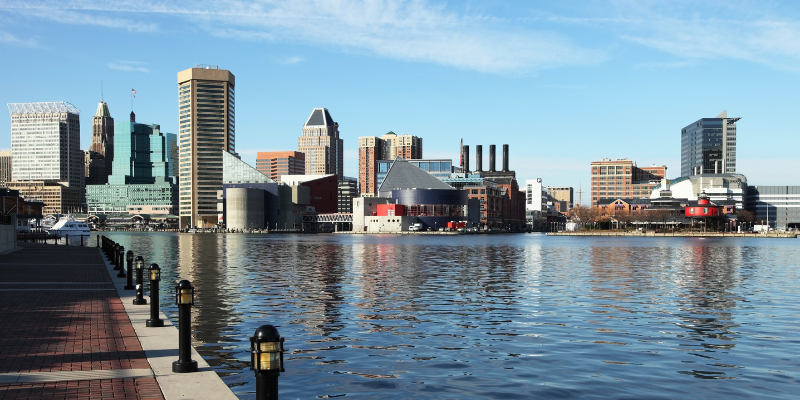Baltimore City Leaders Should Examine Costs of Tax Breaks for Developers to Guide Future Decisions
Last month, a Baltimore City Council committee voted down a bill to study and create a report on the impact of tax increment financing (TIF) to the City’s overall economic development and if such financial tools can be used equitably in underserved communities. The bill would have required several city agencies, including the Finance Department and Department of Housing and Community Development, to collaborate and conduct the study. Despite there being no opposition from the agencies, the bill failed.
Its defeat comes as groups such as the Downtown Partnership of Baltimore continue to propose new TIF districts. Additional tax breaks for developers and big businesses would be a bad deal for city residents and could reinforce the city’s longstanding patterns of racial segregation and under-investment in predominately Black and Brown communities.
Earlier this year the Downtown Partnership of Baltimore’s proposed an area-wide TIF district that would cover the central business district, the Inner Harbor and Harbor East neighborhoods. TIF districts are used to provide low-cost public financing for either public infrastructure or private development projects. They redirect funds from increased property values following a redevelopment project, which normally would go to the city’s general fund, to a special fund used to pay off redevelopment costs, such as bonds or other debt services. Similar programs include Enterprise Zones, which provide tax credits for businesses to create jobs and invest in a selected zoned area.
In theory, these policies can be helpful if well targeted to areas that are in much need of investment. However, in practice, research shows that TIFs and other tax breaks amount to subsidies for large, profitable developers for projects they would have done anyway, at the expense of states and localities in forgone revenue.
Baltimore City has the authority to approve tax abatements for the purpose of encouraging economic development through the Board of Estimates. For context, an Ernst & Young report of Baltimore’s property tax credits found that credits cost the city $126.7 million this year in forgone revenue, with the with cost expected to grow to 9% of revenue by 2031. Much of this has gone to the city’s wealthiest neighborhoods.
Moreover, the TIF district idea the Downtown Partnership proposed covers an area of the city already experiencing significant investment. Harbor Point, Harbor East, and the Central Business District have all experienced growth. The Central Business District is poised for significant growth as the state prepares to move state agency facilities out of the aging State Center complex into downtown, a major state investment in jobs and occupancy. In general, the central business district, by the Downtown Partnership’s own metrics in housing, employment, office occupancy, development, and wage growth, is trending in the right direction.
Harbor Point is another area experiencing strong growth in residency and employment in the last few years. Armada Hoffler Properties, a Virginia Beach based investment firm, staked roughly $1 billion in the area for development projects, including a new headquarters for the giant firm T. Rowe Price as they relocate from downtown, and other residency and parking developments. Further projects are being planned and proposed. Harbor Point has had a TIF in place since 2013 financing bond debt of over $260 million. Adding another TIF district would further reduce tax revenue from this growing area.
The multi-neighborhood TIF district is based on a similar model used in Cincinnati in the early 2000s. The Cincinnati TIF may foreshadow what is to come in Baltimore, as the consequences of foregoing property taxes put a strain on school funding, requiring increased property tax bills to simply maintain funding levels, with no evidence showing positive outcomes for underinvested neighborhoods. Should this proposal be considered, it would likely give tax abatements for residential and commercial properties, with a potential payment in lieu of taxes (PILOT) agreement made between the city and developers as a replacement for paying property taxes. These are typically fraction of the property tax a commercial property owner would normally pay.
With major investments already underway, it is crucial to reconsider subsidizing developer interest at the cost of revenue at a time where the city’s economic heart is already growing considerably. This is a particularly unwise time to chip away at revenues, as the city’s school funding responsibilities are set to grow by $461 million by fiscal year 2030 under the historic Blueprint for Maryland’s Future education reform. The City’s new local contribution, the share of city revenue used to fund schools, began in Fiscal 2023, when operating cost increased by roughly $63 million. The expected growth is estimated at $161.5 million annually, totaling nearly $1 billion in additional City funds over the next decade to match increased state investment in public schools. City leaders are optimistic about meeting the growing requirement, but implementing additional tax breaks would further strain the city’s ability to meet those costs.
Lastly, the Maryland Department of Commerce reworked the Enterprise Zone area in Baltimore City, last designated in 2012 to refocus state tax credits on areas more in need of investment. The rework factored in recent growth trends and added areas like the Pratt Street corridor downtown to help rebound from the COVID-19 pandemic. Notably, it also removed areas such as Harbor East, Harbor Point, and the commercial areas in Federal Hill, all which have seen substantial investments since 2013. This points to the fact that these areas don’t need additional tax breaks/credits to incentivize investments as there has been for some time now. The growth in the Harbor Point and Harbor East neighborhoods present good economic trends for Baltimore, but it would be unwise to use additional subsidies in neighborhoods where they are not needed.
Ultimately, if future TIF districts and other business tax breaks don’t have proper community input, or are deployed in areas already experiencing high growth, the outcome will lead to more inequality, continuing the pattern of disinvestment in Baltimore’s neglected neighborhoods.

